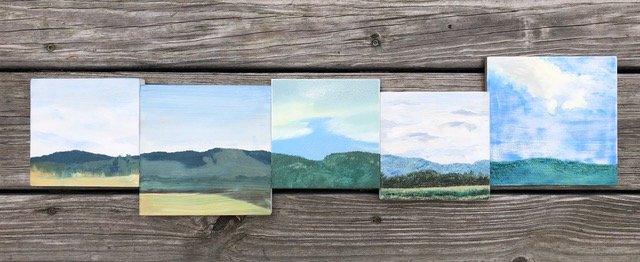Katherine Patterson
Glens Falls, NY
Website
www.katherinempatterson.com
Instagram
@katempatterson
How would you describe your work?
For the past year, I have been working on a series of paintings, drawings and cyanotypes of landscapes that explore the difference between lens-based looking and seeing with the natural eye.
I think about the many ways the world (particularly viewed panoramically) is mediated in order for us to apprehend it- through the sense organs, the camera lens, and digital media- and reflect on how these various distances affect our sense of place, time, and memory.
What inspires you?
I am inspired by my environment- my backyard or a walk with my family. It’s the sense of being present in a particular place that I am chasing.
Can you speak about your process?
I am currently exploring two ways of working:
In one, I sand down old paintings and turn them into new ones by applying thin layers of paint, almost like watercolor, allowing the memory of the older work to show through. I make a series of paintings of one location at various places and times and then assemble the slightly disjointed images together. I think of the cubists, who were trying to paint the experience of actually looking at something phenomenologically, rather than from a single, fixed vantage point.
The other process involves photographing a location, then tracing the image on an iPad to create a hand drawn photographic “negative” which I then print as a cyanotype positive. This lengthy process prompts me to look deeply at a digital image of a place and translate it back into the organic realm of hand, eye, and sunlight. I sometimes think of it as “slow art.”
How did you become interested in art?
I first learned to draw by copying photographs from books. I learned early on that, in a photo, light can be captured in ways that are not always evident in real life. The discrepancy between the camera lens and the human eye still intrigues me today.
Do you have many favorite artists, movies, books, quotes?
I am captivated by the artist Vija Celmins, who succeeds in drawing a photograph of a thing, rather than the thing itself.
I also love classic authors (Dante, Shakespeare, Austen) and television/movies (early Little Rascals, Chaplin, Hitchcock) that speak with still-fresh voices about the human condition.
What advice do you have for younger artists?
Don’t delay marriage or having children in order to pursue an art career. These life-long commitments may compete with your studio time in the short term, but are guaranteed to deepen your art practice and imbue it with meaning in the long term.
Lake George in July, watercolor on paper, 23” x 39”, 2021









